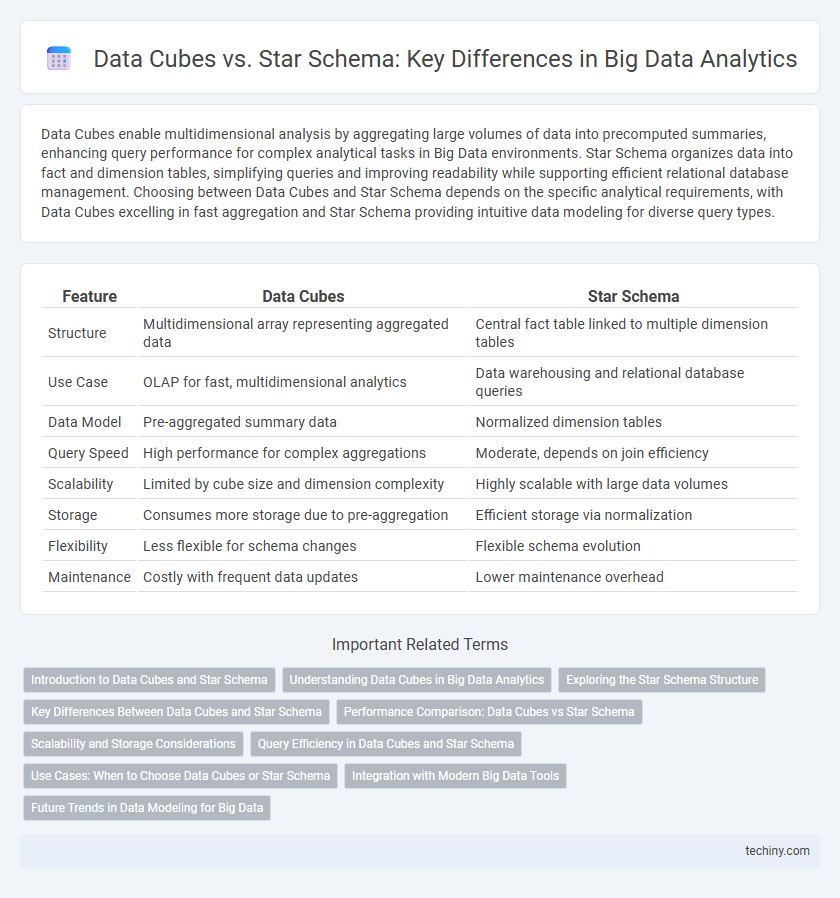Data Cubes enable multidimensional analysis by aggregating large volumes of data into precomputed summaries, enhancing query performance for complex analytical tasks in Big Data environments. Star Schema organizes data into fact and dimension tables, simplifying queries and improving readability while supporting efficient relational database management. Choosing between Data Cubes and Star Schema depends on the specific analytical requirements, with Data Cubes excelling in fast aggregation and Star Schema providing intuitive data modeling for diverse query types.
Table of Comparison
| Feature | Data Cubes | Star Schema |
|---|---|---|
| Structure | Multidimensional array representing aggregated data | Central fact table linked to multiple dimension tables |
| Use Case | OLAP for fast, multidimensional analytics | Data warehousing and relational database queries |
| Data Model | Pre-aggregated summary data | Normalized dimension tables |
| Query Speed | High performance for complex aggregations | Moderate, depends on join efficiency |
| Scalability | Limited by cube size and dimension complexity | Highly scalable with large data volumes |
| Storage | Consumes more storage due to pre-aggregation | Efficient storage via normalization |
| Flexibility | Less flexible for schema changes | Flexible schema evolution |
| Maintenance | Costly with frequent data updates | Lower maintenance overhead |
Introduction to Data Cubes and Star Schema
Data cubes provide a multidimensional array of values allowing efficient data analysis and aggregation across multiple dimensions, essential for Online Analytical Processing (OLAP) in big data environments. Star schema organizes data into fact and dimension tables, optimizing query performance by simplifying relationships and reducing join complexity in data warehousing. Understanding the differences between data cubes and star schema is crucial for designing scalable big data analytics systems that handle complex queries effectively.
Understanding Data Cubes in Big Data Analytics
Data cubes in Big Data analytics enable multidimensional data modeling by organizing and aggregating large datasets across various dimensions such as time, geography, and product categories. This structure supports fast query performance and complex analytical operations like slicing, dicing, and roll-up, essential for uncovering patterns and trends. Compared to star schemas, data cubes provide pre-aggregated views that enhance real-time decision-making in data-intensive environments.
Exploring the Star Schema Structure
The Star Schema structure organizes data into a central fact table connected to multiple dimension tables, optimizing query performance for big data analytics. This design simplifies complex queries by enabling fast aggregation and slicing of multidimensional data, essential for real-time decision-making. Compared to data cubes, the star schema offers greater flexibility and scalability in handling large datasets and evolving analytical requirements.
Key Differences Between Data Cubes and Star Schema
Data Cubes aggregate multidimensional data for rapid query performance in OLAP systems, enabling complex analytical operations across multiple dimensions. Star Schema organizes data into fact tables linked with dimension tables, optimizing relational database queries with simpler join paths for straightforward data warehousing. Key differences include Data Cubes' precomputed aggregates enhancing query speed versus Star Schema's flexibility and simplicity in handling large volumes of detail-level transactional data.
Performance Comparison: Data Cubes vs Star Schema
Data Cubes offer pre-aggregated multidimensional views, enabling faster query performance for complex analytical operations compared to Star Schema, which relies on dynamic joins between fact and dimension tables. Star Schema provides flexibility and simpler design but may experience slower performance on large datasets due to join operations and lack of pre-computed aggregations. Benchmark tests reveal Data Cubes significantly reduce query response times in OLAP environments, especially for high-dimensional, aggregated queries, whereas Star Schemas perform better for straightforward, less complex queries.
Scalability and Storage Considerations
Data cubes enable fast, multi-dimensional querying by pre-aggregating data but often require substantial storage space, impacting scalability in large-scale environments. Star schema simplifies storage with normalized fact and dimension tables, offering better scalability for handling massive datasets but may result in slower query performance due to on-the-fly aggregations. Choosing between data cubes and star schemas depends on balancing storage capacity and query speed needs within big data architectures.
Query Efficiency in Data Cubes and Star Schema
Data cubes enhance query efficiency by pre-aggregating multidimensional data, enabling rapid retrieval for complex analytical queries. Star schemas optimize query performance through simplified join operations between fact and dimension tables, reducing query complexity for large datasets. Both structures improve query efficiency but data cubes excel in OLAP environments with frequent slicing and dicing, while star schemas are preferred for straightforward querying in data warehouses.
Use Cases: When to Choose Data Cubes or Star Schema
Data cubes excel in multidimensional analysis and complex aggregations, making them ideal for OLAP systems requiring rapid, interactive querying of large-scale data sets across multiple dimensions. Star schemas are better suited for straightforward querying and reporting in data warehousing environments where simplicity and query performance on large fact tables are prioritized. Choosing between data cubes and star schemas depends on the need for real-time analytical performance versus ease of implementation and flexibility in ad-hoc queries.
Integration with Modern Big Data Tools
Data Cubes integrate effectively with modern Big Data tools like Apache Hive and Spark by enabling multidimensional analysis and fast OLAP queries through pre-aggregated data structures. Star Schema design aligns well with distributed processing frameworks by simplifying complex joins and improving query performance in platforms such as Hadoop and Amazon Redshift. Leveraging these models enhances scalability and real-time analytics capabilities within contemporary Big Data ecosystems.
Future Trends in Data Modeling for Big Data
Future trends in data modeling for Big Data emphasize enhanced scalability and real-time analytics, where Data Cubes enable multidimensional aggregation for faster query performance, while Star Schemas support intuitive, simplified data navigation through fact and dimension tables. Advances in machine learning-driven automation are expected to optimize schema design, reducing manual intervention and improving data integration across heterogeneous sources. Emerging graph-based extensions and hybrid models combining Data Cubes and Star Schemas aim to address complex relationships and unstructured data challenges prevalent in Big Data ecosystems.
Data Cubes vs Star Schema Infographic

 techiny.com
techiny.com